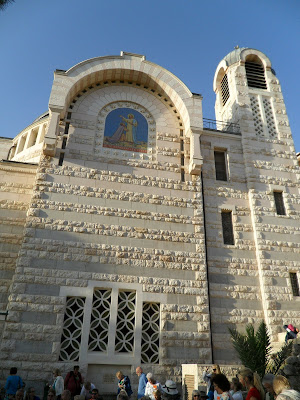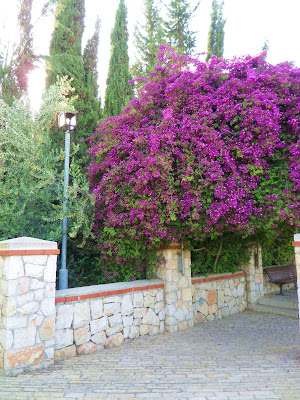 Another early start and we are on our way to the Garden of Gethsemane.
Another early start and we are on our way to the Garden of Gethsemane. In the upper left hand corner of the above picture is a tomb with a conical roof called Absalom's tomb or also referred to as Absalom's Pillar. Located in the Kidron Valley this shrine is ascribed to Absalom based on 2 Samuel 18:18.
In the upper left hand corner of the above picture is a tomb with a conical roof called Absalom's tomb or also referred to as Absalom's Pillar. Located in the Kidron Valley this shrine is ascribed to Absalom based on 2 Samuel 18:18.According to Wikipedia, for centuries, it was the custom among passersby—Jews, Christians and Muslims—to throw stones at the monument. Residents of Jerusalem would bring their unruly children to the site to teach them what became of a rebellious son. The Monument of Absalom existed in the days of Josephus, and was referred to in his Antiquities. With that bit of trivia, I wish I had gotten a better picture!!



 We are entering the private Garden of Gethsemane and I had to take a moment for this picture.
We are entering the private Garden of Gethsemane and I had to take a moment for this picture. Dr. Joel Rosenberg (black shirt) had just video taped a message for his website and was leaving.
Dr. Joel Rosenberg (black shirt) had just video taped a message for his website and was leaving. A sweet couple from Colorado (whom I wish would come to Texas for a visit) surreptitiously took this picture of me praying in the garden.
A sweet couple from Colorado (whom I wish would come to Texas for a visit) surreptitiously took this picture of me praying in the garden. Yes, it is another picture of the gate!
Yes, it is another picture of the gate! This is the public side of the Garden of Gethsemane. It is very well tended, beautiful and as a result fenced off from the public pedestrian traffic.
This is the public side of the Garden of Gethsemane. It is very well tended, beautiful and as a result fenced off from the public pedestrian traffic.



 The church is Roman Catholic and it enshrines a portion of the bedrock where Jesus is said to have prayed before he was arrested. The edging around the rock looks like crowns of thorns. I pulled this picture from the Sacred Destinations website because the day we were there the rock was surrounded by a group from India that were so overcome by emotion that they were kneeling around the rock and kissing it.
The church is Roman Catholic and it enshrines a portion of the bedrock where Jesus is said to have prayed before he was arrested. The edging around the rock looks like crowns of thorns. I pulled this picture from the Sacred Destinations website because the day we were there the rock was surrounded by a group from India that were so overcome by emotion that they were kneeling around the rock and kissing it. These old olive trees were beautiful in their own way. What was hard for me to understand was the people that were reaching through the fence to take a piece of bark of the oldest olive tree. Yes, it was living in the time of Jesus but if you have accepted Christ as your personal Savior, He lives in you! If you're not sure, read 1John.
These old olive trees were beautiful in their own way. What was hard for me to understand was the people that were reaching through the fence to take a piece of bark of the oldest olive tree. Yes, it was living in the time of Jesus but if you have accepted Christ as your personal Savior, He lives in you! If you're not sure, read 1John. These last two pictures are two of my favorites because the monk provides an even more tranquil look to the garden. And the picture below is another view of the oldest olive tree.
These last two pictures are two of my favorites because the monk provides an even more tranquil look to the garden. And the picture below is another view of the oldest olive tree.
They came to a place named Gethsemane; and He said to His disciples, “Sit here until I have prayed.” And He took with Him Peter and James and John, and began to be very distressed and troubled. And He said to them, “My soul is deeply grieved to the point of death; remain here and keep watch.” And He went a little beyond them, and fell to the ground and began to pray that if it were possible, the hour might pass Him by. And He was saying, “Abba! Father! All things are possible for You; remove this cup from Me; yet not what I will, but what You will.” And He came and found them sleeping, and said to Peter, “Simon, are you asleep? Could you not keep watch for one hour? Keep watching and praying that you may not come into temptation; the spirit is willing, but the flesh is weak.” Again He went away and prayed, saying the same words. And again He came and found them sleeping, for their eyes were very heavy; and they did not know what to answer Him. And He came the third time, and said to them, “Are you still sleeping and resting? It is enough; the hour has come; behold, the Son of Man is being betrayed into the hands of sinners. Get up, let us be going; behold, the one who betrays Me is at hand!”








 The Lord turned and looked at Peter. And Peter remembered the word of the Lord, how He had told him, “Before a rooster crows today, you will deny Me three times.” 62 And he went out and wept bitterly. Luke 22:61-62
The Lord turned and looked at Peter. And Peter remembered the word of the Lord, how He had told him, “Before a rooster crows today, you will deny Me three times.” 62 And he went out and wept bitterly. Luke 22:61-62














 Bloomfield Park
Bloomfield Park













